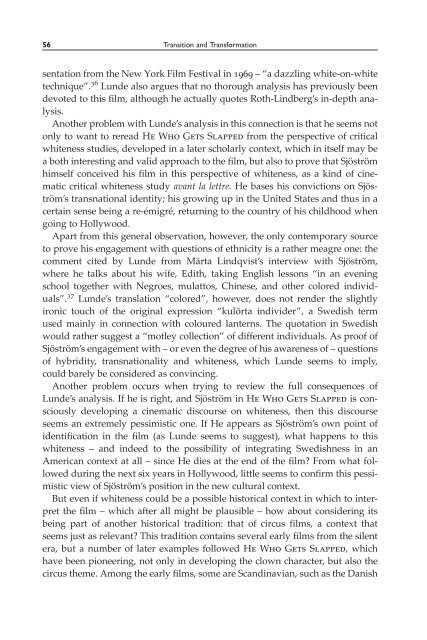FILM FILM - University of Macau Library
FILM FILM - University of Macau Library
FILM FILM - University of Macau Library
You also want an ePaper? Increase the reach of your titles
YUMPU automatically turns print PDFs into web optimized ePapers that Google loves.
56 Transition and Transformation<br />
sentation from the New York Film Festival in 1969 –“a dazzling white-on-white<br />
technique”. 36 Lunde also argues that no thorough analysis has previously been<br />
devoted to this film, although he actually quotes Roth-Lindberg’s in-depth analysis.<br />
Another problem with Lunde’s analysis in this connection is that he seems not<br />
only to want to reread He Who Gets Slapped from the perspective <strong>of</strong> critical<br />
whiteness studies, developed in a later scholarly context, which in itself may be<br />
a both interesting and valid approach to the film, but also to prove that Sjöström<br />
himself conceived his film in this perspective <strong>of</strong> whiteness, as a kind <strong>of</strong> cinematic<br />
critical whiteness study avant la lettre. He bases his convictions on Sjöström’s<br />
transnational identity; his growing up in the United States and thus in a<br />
certain sense being a re-émigré, returning to the country <strong>of</strong> his childhood when<br />
going to Hollywood.<br />
Apart from this general observation, however, the only contemporary source<br />
to prove his engagement with questions <strong>of</strong> ethnicity is a rather meagre one: the<br />
comment cited by Lunde from Märta Lindqvist’s interview with Sjöström,<br />
where he talks about his wife, Edith, taking English lessons “in an evening<br />
school together with Negroes, mulattos, Chinese, and other colored individuals”.<br />
37 Lunde’s translation “colored”, however, does not render the slightly<br />
ironic touch <strong>of</strong> the original expression “kulörta individer”, a Swedish term<br />
used mainly in connection with coloured lanterns. The quotation in Swedish<br />
would rather suggest a “motley collection” <strong>of</strong> different individuals. As pro<strong>of</strong> <strong>of</strong><br />
Sjöström’s engagement with – or even the degree <strong>of</strong> his awareness <strong>of</strong> – questions<br />
<strong>of</strong> hybridity, transnationality and whiteness, which Lunde seems to imply,<br />
could barely be considered as convincing.<br />
Another problem occurs when trying to review the full consequences <strong>of</strong><br />
Lunde’s analysis. If he is right, and Sjöström in He Who Gets Slapped is consciously<br />
developing a cinematic discourse on whiteness, then this discourse<br />
seems an extremely pessimistic one. If He appears as Sjöström’s own point <strong>of</strong><br />
identification in the film (as Lunde seems to suggest), what happens to this<br />
whiteness – and indeed to the possibility <strong>of</strong> integrating Swedishness in an<br />
American context at all – since He dies at the end <strong>of</strong> the film? From what followed<br />
during the next six years in Hollywood, little seems to confirm this pessimistic<br />
view <strong>of</strong> Sjöström’s position in the new cultural context.<br />
But even if whiteness could be a possible historical context in which to interpret<br />
the film – which after all might be plausible – how about considering its<br />
being part <strong>of</strong> another historical tradition: that <strong>of</strong> circus films, a context that<br />
seems just as relevant? This tradition contains several early films from the silent<br />
era, but a number <strong>of</strong> later examples followed He Who Gets Slapped, which<br />
have been pioneering, not only in developing the clown character, but also the<br />
circus theme. Among the early films, some are Scandinavian, such as the Danish

















